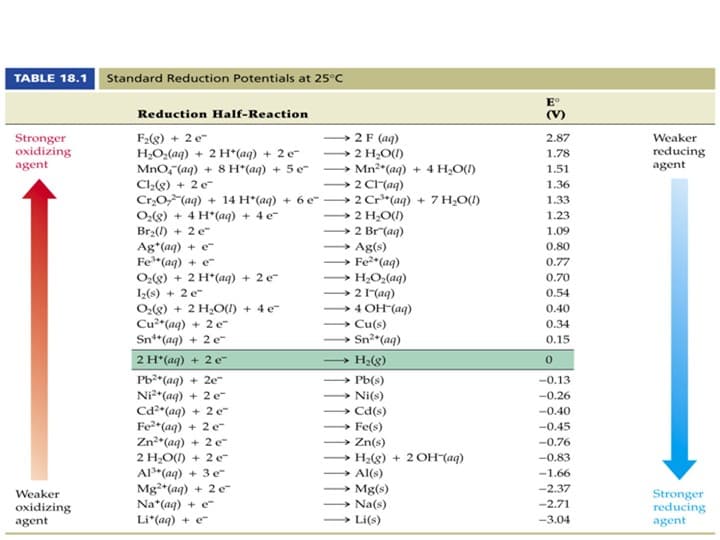Chemistry: The Molecular Science
5th Edition
ISBN:9781285199047
Author:John W. Moore, Conrad L. Stanitski
Publisher:John W. Moore, Conrad L. Stanitski
Chapter17: Electrochemistry And Its Applications
Section: Chapter Questions
Problem 92QRT
Related questions
Question
Use the tabulated electrode potentials to calculate K for the oxidation of iron by H++ (at 25°C):
2Fe(s)+6H+(aq)→2Fe3+(aq)+3H2(g)

Transcribed Image Text:TABLE 18.1
Standard Reduction Potentials at 25°C
E°
Reduction Half-Reaction
(V)
2 F (aq)
Stronger
oxidizing
agent
F2(g) +
H2O;(aq) + 2 H*(aq) + 2 e-
MnO, (aq) + 8 H*(aq) + 5 e
Cl2(8) + 2 e-
Cr,0, (aq) + 14 H*(aq) + 6 e
O:(8) + 4 H*(aq) + 4 e-
Br2(1) + 2 e
Ag*(aq) + e
Fe*(aq) + e
Oz(g) + 2 H*(aq) + 2 e
I2(s) + 2 e-
O:(g) + 2 H,O(1) + 4 e-
Cu2*(aq) + 2 e
Sn*(aq) + 2 e
2 e
2.87
Weaker
reducing
agent
2 H;O(I)
1.78
→ Mn2 (aq) + 4 H,O(1)
→2 CI(aq)
→2 Cr* (aq) + 7 H;O()
→ 2 H;O(I)
→2 Br (aq)
→ Ag(s)
Fe2*(aq)
(bv)O°H
2 1 (aq)
→ 4 OH"(aq)
1.51
1.36
1.33
1.23
1.09
0.80
0.77
0.70
0.54
0.40
Cu(s)
0.34
• Sn²*(aq)
0.15
2 H*(aq) + 2 e-
Pb2*(aq) + 2e
Ni2*(aq)
Pb(s)
Ni(s)
→ Cd(s)
→ Fe(s)
-0.13
+ 2 e
Cd2*(aq) + 2 e
Fe2*(aq) + 2 e
Zn2*(aq) + 2 e-
2 H,O() + 2 e
Al"(aq) + 3 e
Mg*(aq) + 2e
Na*(aq) + e-
Li*(aq) + e
-0.26
-0.40
-0.45
>Zn(s)
→ H2(g) + 2 OH(aq)
→ Al(s)
→ Mg(s)
→ Na(s)
→ Li(s)
-0.76
-0.83
-1.66
-2.37
Stronger
reducing
agent
Weaker
-2.71
oxidizing
agent
-3.04
Expert Solution
This question has been solved!
Explore an expertly crafted, step-by-step solution for a thorough understanding of key concepts.
This is a popular solution!
Trending now
This is a popular solution!
Step by step
Solved in 2 steps with 1 images

Knowledge Booster
Learn more about
Need a deep-dive on the concept behind this application? Look no further. Learn more about this topic, chemistry and related others by exploring similar questions and additional content below.Recommended textbooks for you

Chemistry: The Molecular Science
Chemistry
ISBN:
9781285199047
Author:
John W. Moore, Conrad L. Stanitski
Publisher:
Cengage Learning

Chemistry & Chemical Reactivity
Chemistry
ISBN:
9781133949640
Author:
John C. Kotz, Paul M. Treichel, John Townsend, David Treichel
Publisher:
Cengage Learning

Chemistry & Chemical Reactivity
Chemistry
ISBN:
9781337399074
Author:
John C. Kotz, Paul M. Treichel, John Townsend, David Treichel
Publisher:
Cengage Learning

Chemistry: The Molecular Science
Chemistry
ISBN:
9781285199047
Author:
John W. Moore, Conrad L. Stanitski
Publisher:
Cengage Learning

Chemistry & Chemical Reactivity
Chemistry
ISBN:
9781133949640
Author:
John C. Kotz, Paul M. Treichel, John Townsend, David Treichel
Publisher:
Cengage Learning

Chemistry & Chemical Reactivity
Chemistry
ISBN:
9781337399074
Author:
John C. Kotz, Paul M. Treichel, John Townsend, David Treichel
Publisher:
Cengage Learning

Chemistry: Principles and Practice
Chemistry
ISBN:
9780534420123
Author:
Daniel L. Reger, Scott R. Goode, David W. Ball, Edward Mercer
Publisher:
Cengage Learning


Chemistry
Chemistry
ISBN:
9781305957404
Author:
Steven S. Zumdahl, Susan A. Zumdahl, Donald J. DeCoste
Publisher:
Cengage Learning